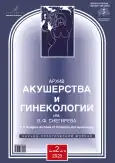Results of surgical treatment of polycystic ovarian syndrome in women of reproductive age
- Authors: Sosnova E.A.1, Gracheva T.S.1
-
Affiliations:
- I.M. Sechenov First Moscow State Medical University (Sechenov University)
- Issue: Vol 10, No 2 (2023)
- Pages: 105-111
- Section: Original study articles
- URL: https://journal-vniispk.ru/2313-8726/article/view/219147
- DOI: https://doi.org/10.17816/2313-8726-2023-10-2-105-111
- ID: 219147
Cite item
Full Text
Abstract
BACKGROUND: Polycystic ovarian syndrome (PCOS) is one of the most common and to some extent mysterious diseases falling under the competence of gynecologists. PCOS occurs in 5–10% of women of reproductive age. This paper presented the long-term results of surgical treatment of patients with PCOS.
AIM: This study aimed to determine the efficiency of surgical treatment of the ovaries to restore reproductive function in women with PCOS.
MATERIALS AND METHODS: The initial diagnosis of PCOS was made at the outpatient examination. The study included 121 women of reproductive age diagnosed with PCOS when other factors of infertility and menstrual dysfunction were excluded. Patients with PCOS as an initial diagnosis for hospitalization and absence of tubal-peritoneal infertility and male infertility were included. All patients (n = 121) underwent surgical treatment and histological examination. Patients were referred for treatment to gynecological surgical hospitals. In particular, 54 (group 1), 48 (group 2), and 19 (group 3) women were treated in a municipal clinical hospital, research center, and commercial clinic, respectively. Statistical data analysis was performed with the STATISTICA Base software package using parametric and nonparametric methods. Arithmetic mean, standard deviations, medians, and percentiles of the indices were calculated. Confidence limits to the arithmetic mean were calculated based on Student’s distribution. The exact 95% confidence limits to frequencies and the reliability of differences in frequencies between the groups were determined using binomial distribution and the chi-square test, respectively. In addition, the Mann–Whitney (U) and Wilcoxon nonparametric tests were used because several indicators had significantly normal distributions. Differences were considered statistically significant at p <0.05.
RESULTS: Of the total number of patients (n = 121), 108 (89%) became pregnant postoperatively, and 13 (11%) did not. Moreover, 47 (39%) of the total number of patients became pregnant for up to 1 year and 61 (50%) for over a year, and 48 (39.6%) of 108 patients became pregnant post-in vitro fertilization (IVF, 1–2 attempts in 37 (32%) and more than 3 attempts in 11, or 9% patients). PCOS was confirmed in 6 (14%) patients; of these, spontaneous pregnancy occurred in 5 (83%), including 4 patients in the first year and 1 in over a year. These patients had clinical and biochemical signs of hyperandrogenism and insulin resistance.
PCOS-like conditions were diagnosed in 37 (86%) patients; of these, pregnancy occurred in 33 (89%), including spontaneous pregnancy in 10, or 27% (4 within 1 year and 6 over 1 year) patients. Post-IVF pregnancy was diagnosed in 23 (62%) patients (1–2 attempts in 20, or 54.1%, and more than 3 attempts in 3, or 8.1% women).
CONCLUSIONS: Surgical treatment of patients with PCOS is an independent treatment of this gynecological and metabolically burdened disease. This method has both indications and contraindications, and it has specific types, which require certain patient preparations, such as weight loss, blood glucose control, hyperinsulinemia analysis, and compensation of arterial hypertension, to increase treatment efficiency.
Full Text
##article.viewOnOriginalSite##About the authors
Elena A. Sosnova
I.M. Sechenov First Moscow State Medical University (Sechenov University)
Author for correspondence.
Email: sosnova-elena@inbox.ru
ORCID iD: 0000-0002-1732-6870
SPIN-code: 6313-9959
MD, Dr. Sci. (Med.), Professor
Russian Federation, 2, build. 4, B. Pirogovskaya str., 119991 MoscowTat’yana S. Gracheva
I.M. Sechenov First Moscow State Medical University (Sechenov University)
Email: gracheva_91@mail.ru
ORCID iD: 0000-0001-5102-5310
graduate student
Russian Federation, 2, build. 4, B. Pirogovskaya str., 119991 MoscowReferences
- Artifeksov SB, Zachepilo EN, Zachepilo AV, Sergeev SYu, Sedysheva IV. Features of the current demographic situation in Russia // Proceedings of the XVII Annual International Conference of the Russian Association of Human Reproduction «Reproduktivnye tekhnologii segodnya i zavtra»; 2007 Sept 6–8; Kazan. Available from: Teziss_XVII_2007_pages.pdf (In Russ).
- Kulakov VI, Leonov BV, Kuz'michev LN, editors. Treatment of female and male infertility. Assisted reproductive technologies. Moscow: Medical Information Agency; 2005. (In Russ).
- Sirmans SM, Pate KA. Epidemiology, diagnosis, and management of polycystic ovary syndrome. Clin Epidemiol. 2013;6:1–13.doi: 10.2147/CLEP.S37559
- Drosdzol-Cop A, Sidło-Stawowy A, Sajdak D, Skrzypulec-Plinta V. Diagnosing polycystic ovary syndrome in adolescent girls. Ginekol Pol. 2014;85(2):145–148. doi: 10.17772/gp/1705
- Siristatidis ChC, Maheshwari A, Vaidakis D, Bhattacharya S. In vitro maturation in subfertile women with polycystic ovarian syndrome undergoing assisted reproduction. Cochrane Database Syst Rev. 2018;11(11):CD006606. doi: 10.1002/14651858.CD006606.pub4
- Balen AH, Conway GS, Homburg R, Legro RS. Polycystic Ovary Syndrome. A Guide to Clinical Management. CRC Press; 2005. 230 p. doi: 10.3109/9780203506158
- Pozdnyakova TI, Serova OF, Zarochentseva NV. Aktual’nye voprosy diagnostiki i lecheniya besplodiya u zhenshchin s sindromom polikistoznykh yaichnikov. Voprosy ginekologii, akusherstva i perinatologii. 2004;3(1):80–85. (In Russ).
- Klein DA, Paradise SL, Reeder RM. Amenorrhea: A Systematic Approach to Diagnosis and Management. Am Fam Physician. 2019;100(1):39–48.
- Hickey M, Balen A. Menstrual disorders in adolescence: investigation and management. Hum Reprod Update. 2003;9(5):493–504. doi: 10.1093/humupd/dmg038
- Mozheiko LF, Lobachevskaya OS, Romanchuk JV, et al. Modern methods of infertility treatment in patients with PCOS. Maternity and Child Welfare. 2014;(1):104–106. (In Russ).
- Shepel’kevich AP, Barsukov AN, Mantachik MV. Sovremennye podkhody k diagnostike i lecheniyu sindroma polikistoznykh yaichnikov. Lechebnoe delo. 2014;(2):21–26. (In Russ).
Supplementary files







